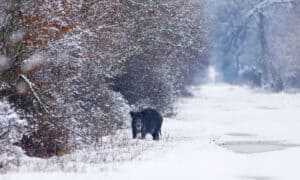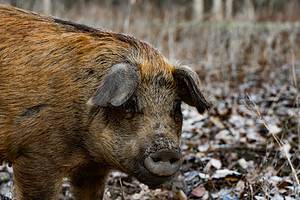Wild boars, also known as feral pigs or wild hogs, are omnivorous animals that inhabit several regions worldwide. Recognized as significant ecological and agricultural pests, Wild boars have destructive feeding habits and a propensity for disease transmission. However, the narrative of wild boars in Colorado is a curious one.

Wild boars are not common in Colorado.
©Ondrej Prosicky/Shutterstock.com
Wild Boar Population in Colorado
Contrary to many other US states, especially those in the southern region, such as Texas and Florida, Colorado has not historically been a hotspot for wild boar populations. Colorado is not among the states significantly affected by feral swine. The relatively low populations of wild boars in the state are due to a range of factors, from climate and geography to stringent wildlife management policies aimed at controlling this invasive species.
The Colorado Parks and Wildlife (CPW) has been conducting a proactive and aggressive eradication program to keep these destructive animals at bay by eradicating them from the state and preventing established breeding. By doing so, CPW preserves Colorado’s unique ecosystems by protecting the state’s valuable natural resources and vibrant agricultural industry from the extensive damage wild boars can inflict.
Public policies to preserve wildlife and natural habitats often grapple with the fine balance of maintaining biodiversity while keeping invasive species in check. As such, understanding the population dynamics of wild boars in Colorado serves as an example of effective wildlife management that protects the integrity of ecosystems.
The discussion surrounding the population of wild boars in Colorado serves as a reminder of the need for continued research, surveillance, and management to mitigate the impacts of invasive species. Moreover, it underscores the importance of an informed public in supporting these efforts.
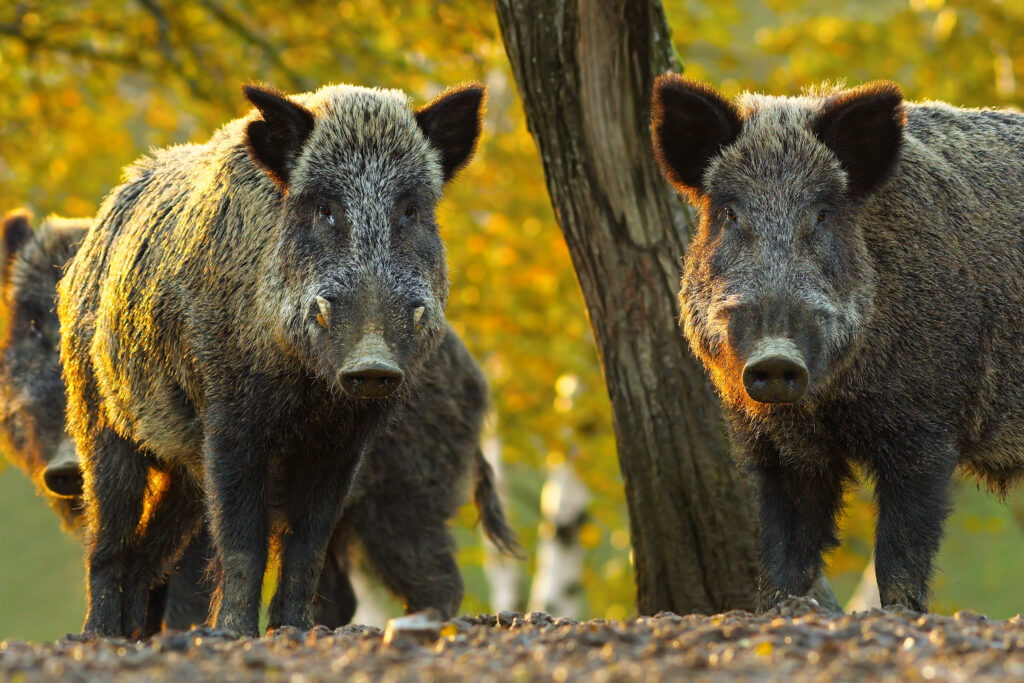
Wild boars are extremely adaptable.
©iStock.com/taviphoto
Where to Find Wild Boars in Colorado
Encountering wild boars is highly unlikely but certainly possible.
Historically, sightings of wild boars in Colorado have been relatively rare and isolated. Human intervention has been the cause of most of these sightings. Examples include the temporary wild boar populations that appeared in Moffat County in the northwest and Baca County in the southeast, which we will explore later in this article. These populations were likely a result of escapees from private game farms or illegal releases for hunting purposes.
It’s also worth noting that the state shares borders with several states where wild boar populations are more established. Therefore, sightings could occur in border regions due to boars roaming from neighboring states. However, this is rare due to the vigilant surveillance and quick action of the CPW.
So while it’s theoretically possible to encounter wild boars in Colorado, the chances are quite low due to the state’s wildlife management agencies’ active prevention and eradication efforts. The focus has been to prevent the establishment of wild boars rather than allow their numbers to increase and then try to control them. This approach has so far been highly effective, and it stands as a testament to the critical role of wildlife management in preserving the integrity of our ecosystems. Any potential sightings would likely be tied to illegal human activities, such as releasing wild boars for hunting.
It’s also crucial to emphasize that releasing wild boars into the wild is illegal and highly discouraged due to the extensive environmental and agricultural damage these animals can cause. Residents and visitors should report any wild boar sightings to the CPW to aid in the ongoing effort to prevent the establishment of these invasive animals in the state.

Wild boars can produce multiple litters each year.
©Rudmer Zwerver/Shutterstock.com
Wild Boars Are an Invasive Species
The distribution of wild boars in Colorado offers an interesting perspective on the interaction between wildlife, humans, and the environment. While many might envision a sighting of these robust creatures as they traipse through the Colorado wildlands, it’s essential to note that these animals, originally domesticated pigs that went feral, are not native to North America. Hence, they are not typically part of Colorado’s diverse wildlife panorama.
The story of wild boars in Colorado is not one of frequent encounters or widespread populations. Instead, it’s a tale of prevention, caution, and relentless efforts by wildlife agencies, hunters, conservationists, and landowners to keep these invasive creatures at bay. Unlike other states like Texas or Florida, where wild boars roam in their millions, Colorado has managed to maintain a vigilant stand against the establishment of wild boars within its borders.
Wild boars have an uncanny ability to survive and thrive in various habitats, from forests and grasslands to marshes and deserts. They cause considerable harm to native wildlife, flora, and human enterprise. Given their potential for wreaking havoc, Colorado’s approach to managing wild boar populations has been decidedly aggressive, with the Colorado Parks and Wildlife (CPW) Department aiming for total eradication rather than control.
Even though wild boars are fascinating creatures with their thick, bristly coats, long snouts, and notable tusks, we cannot overlook the frequent harm they cause to native ecosystems. They are a stark reminder of the need for effective wildlife management practices and public awareness about invasive species impacts.
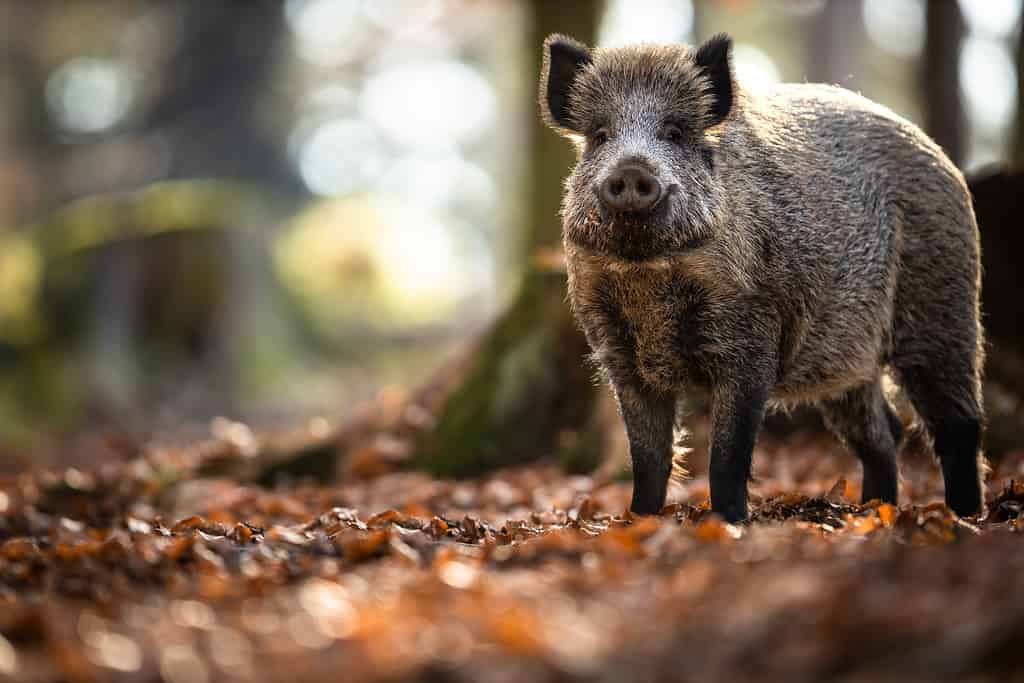
Wild boars are an invasive species.
©iStock.com/ViktorCap
Are Wild Boars Dangerous?
In short, yes, wild boars are not only dangerous to the environment but also pose a significant risk to humans. Here are four reasons why.
1. Physical Threat to Humans
Wild boars are large, powerful animals equipped with sharp tusks. They can be aggressive, especially if they feel threatened or if a mother boar (sow) is protecting her young (piglets). While attacks on humans are relatively rare, they can occur and are capable of causing severe injury and, in rare cases, even death.
2. Disease Transmission
Wild boars can carry and transmit a variety of diseases that can affect humans, livestock, and wildlife. These diseases include swine brucellosis, pseudorabies, trichinosis, and leptospirosis, among others.
3. Environmental and Agricultural Damage
Wild boars are known for their destructive feeding habits. They will dig up large areas of land in search of food, a behavior known as rooting. This behavior can cause extensive damage to crops, pastures, and natural habitats, which can have significant economic impacts. Additionally, by altering the physical environment, they can negatively affect other wildlife species and overall biodiversity.
4. Impact on Native Species
As an invasive species in many areas, wild boars can outcompete native wildlife for food and other resources. They also prey on a variety of organisms. These organisms include the eggs and young of ground-nesting birds and reptiles, which can impact native species populations.
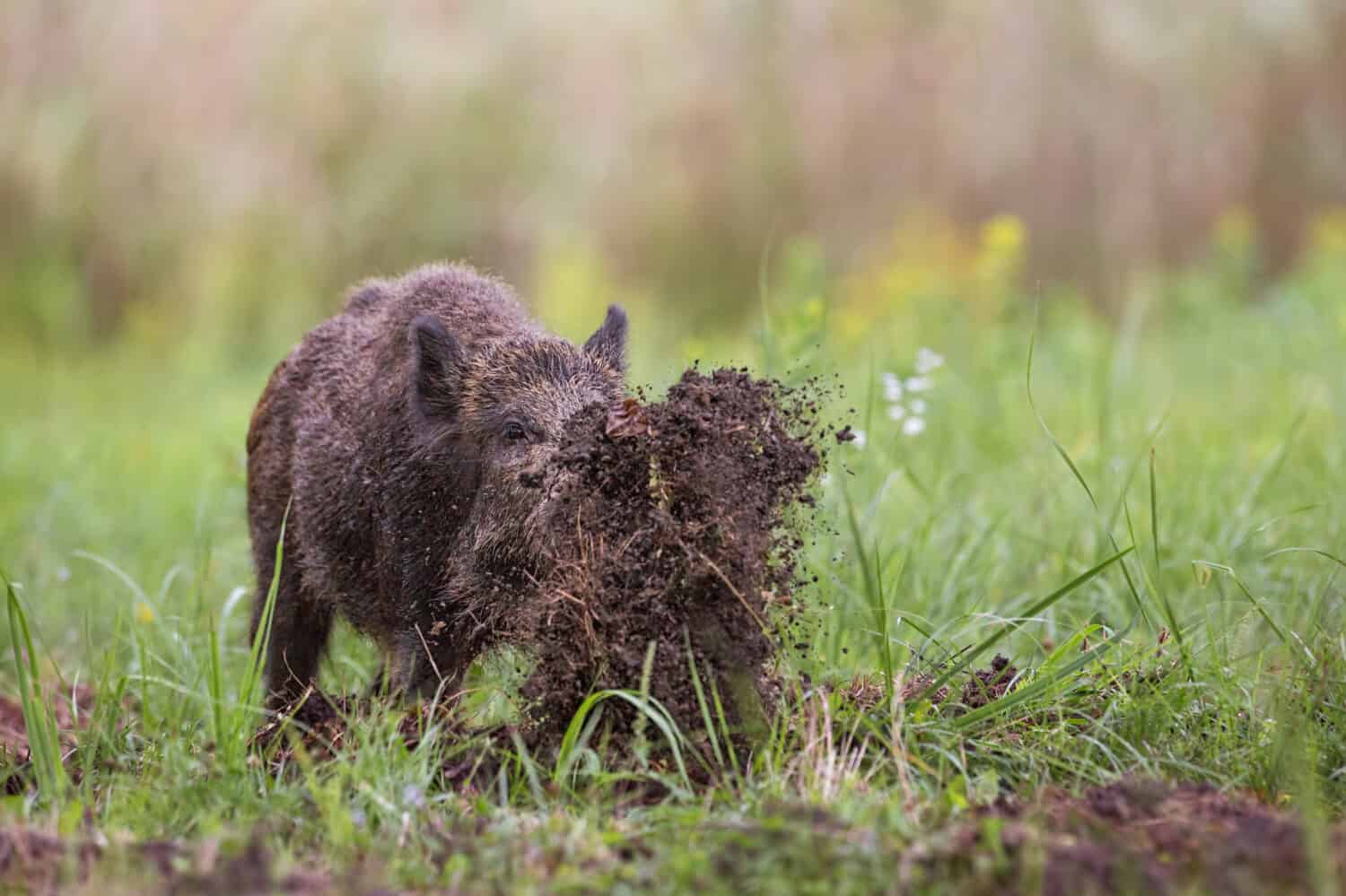
Wild boars are destructive to the natural ecosystem.
©WildMedia/Shutterstock.com
History of Wild Boars in Colorado
These adaptable creatures, descendent of domestic pigs, were brought over by Spanish and European explorers and settlers in the 16th century. Over time, these domestic pigs escaped or were released, and their progeny adapted to life in the wild, evolving into the wild boars, we know today. The species spread across much of the United States, displaying an uncanny knack for survival and reproduction. However, their presence in Colorado has historically been somewhat sporadic, thanks to the vigilance of state wildlife agencies.
Moffat County Wild Boar Population
In the early 2000s, there were reports of an established wild boar population in Moffat County, situated in Colorado’s northwest region. These were likely escapees from private game farms or individuals illegally transported and released for hunting purposes. Their arrival signaled a potential ecological disaster, given their well-known proclivity for damaging natural and agricultural landscapes. However, the CPW and the United States Department of Agriculture (USDA) stepped up and mounted an aggressive response. The result was successfully eradicating this population, preserving the integrity of the local ecosystem. As well as preventing the establishment of wild boars in the area.
Baca County Wild Boar Population
Fast forward to 2019, there was another report of a group of wild boars, but this time in Baca County, located in the state’s southeast corner. Once again, this signaled a potential threat to Colorado’s natural landscape and agricultural industry. CPW, in coordination with USDA and local landowners, responded swiftly. By the end of that year, the CPW and the USDA had successfully eliminated the wild boar population in Baca County. These efforts by the CPW have helped Colorado maintain its status as a state with minimal feral swine populations.
Prevention vs. Population Control
Colorado’s policy towards wild boars is quite clear; prevention and eradication rather than control. Recognizing the extensive damage these invasive animals can cause to the environment and agriculture, the state has focused on preventing their establishment. This approach stands as a testament to the effectiveness of proactive wildlife management strategies. It underscores the vital role these strategies play in preserving our ecosystems.
The history of wild boars in Colorado is not a tale of a growing population, as in many other states. Instead, it’s a story of successful wildlife management, proactive response, and a commitment to preserving the state’s natural and agricultural landscapes from invasive and destructive species.
Despite these past successes, the vigilance must continue. Wild boars are notoriously hard and adaptable creatures. They reproduce quickly, and their populations can explode under the right conditions. Moreover, illegal transport and release of wild boars for hunting continue to pose a threat. Hence, ongoing monitoring, public awareness campaigns, and strong enforcement measures remain critical in preventing the establishment of wild boars in Colorado.

Colorado’s policy against wild boars is prevention and eradication rather than control.
©iStock.com/JMrocek
Can You Hunt Wild Boars in Colorado?
In the grand landscape of Colorado, the topic of wild boar hunting presents an interesting paradox. In many parts of the United States, hunting is often employed as a method of controlling wild boar populations. Largely due to their fast reproduction rates and the significant environmental and agricultural damage they can cause. However, Colorado’s stance on wild boars and their hunting is uniquely different. It serves as a testament to the state’s proactive and aggressive wildlife management strategy.
It’s Complicated
The short answer to the question is yes and no. As of 2023, holding a specific license to hunt wild boars is not required as an individual. However, commercial hunting is prohibited. It is also worth noting that Colorado’s wild boar population is incredibly slim. It is generally not a state for wild boar hunting. But if you cross paths with them, you have the legal right to hunt them. However, releasing wild boars for hunting in the state is illegal. It is a slightly gray area, as hunting can be seen as a population control method. However, it can quickly lead to individuals releasing wild boars to establish hunting game to serve hunting clients.
Colorado Parks and Wildlife (CPW) has maintained a clear policy toward wild boars with prevention and eradication rather than control. Recognizing the potential havoc these animals can wreak on natural ecosystems and agricultural lands, the state has focused its efforts on stopping these animals from establishing themselves in the first place.
This policy came about due to two key factors. First, wild boars are highly prolific breeders. A single female can produce multiple litters each year, leading to exponential population growth in a relatively short time. Second, wild boars are known for their adaptability. They can thrive in a variety of environments, from marshes and forests to grasslands and deserts. This adaptability makes them especially challenging to control once they establish a population.
Additionally, allowing the hunting of wild boars could unintentionally encourage illegal releases. In some instances, individuals release wild boars into the wild to create hunting game. This occurrence is a significant concern, as these illegally released animals can become the founders of new wild boar populations.
Wild Boar Management in Colorado Is Multifaceted
For these reasons, Colorado has set specific guidelines for hunting wild boars. The state focuses on immediate eradication by wildlife agencies when wild boars are detected. All wild boar sightings are encouraged to be reported to the Colorado Parks and Wildlife Department immediately. The CPW, in partnership with other agencies and landowners, has been successful in eliminating isolated populations of wild boars. Which has kept Colorado largely free from these invasive creatures.
The approach taken by Colorado underscores the complexity of wildlife management. In addition to the need for strategies that consider the unique behaviors and impacts of different species. While hunting may be a tool for controlling some wildlife populations, the prevention and immediate eradication have proven more effective for wild boars in Colorado.

The population management of wild boars in Colorado has been incredibly successful.
©Martin Mecnarowski/Shutterstock.com
Conclusion
The history of wild boars in Colorado paints a unique picture in the realm of wildlife management. As we look back, we see a state that has taken a proactive approach to preventing the establishment and spread of wild boars, deviating from the reactive policies commonly observed in other parts of the country. Colorado’s continuous effort to eradicate this invasive species, rather than attempting to control it, has proven successful in protecting its diverse and delicate ecosystems.
For some, the scarcity of wild boars in Colorado may seem surprising. Especially given the extensive spread of this adaptable species in other regions of the United States. Wild boars are highly resilient creatures with a remarkable ability to adapt to various habitats, coupled with an alarming reproductive rate. When left unchecked, these characteristics can lead to a rapid surge in population numbers, causing significant ecological and agricultural damage.
Management Efforts by Colorado Parks and Wildlife Have Proven Highly Effect
However, this is not the case in Colorado. The state has maintained a low wild boar population due to rigorous and ongoing management efforts by CPW. In addition to the cooperation of local landowners and the public. Any isolated wild boar sightings or population growth have been swiftly addressed, with successful eradication campaigns undertaken in Moffat County and Baca County. This commitment to prevention and quick action has been vital in maintaining the state’s diverse ecosystems and vibrant agricultural landscapes.
The minimal wild boar population in Colorado is primarily attributed to the CPW’s aggressive wildlife management policies. Which have been highly successful in preventing these animals from establishing populations. But, it is also a testament to the cooperative efforts of the public, who are encouraged to report any wild boar sightings to the CPW immediately. This collaboration exemplifies the importance of community participation in protecting our natural resources. It emphasizes the critical role of public awareness in preserving the delicate balance of our ecosystems.
Hunting Wild Boars in Colorado Isn’t Encouraged, but Reporting Sightings Is
When we explore the issue of wild boar hunting in Colorado, we find another unique aspect of the state’s approach. In other regions, hunting is used as a means of population control. In Colorado, however, hunting wild boars is not encouraged. It is not illegal for individuals to hunt these animals. But the act of releasing wild boars for hunting purposes is strictly prohibited. This approach is due to several reasons. Including the understanding that although hunting can be an effective method of population control, it could inadvertently lead to the illegal release of these animals. Which can result in the establishment of new wild boar populations.
In essence, Colorado’s policy towards wild boars, encompassing its prevention-focused management strategies and hunting regulations, reflects its dedication to preserving its unique ecosystems. It serves as a striking example of proactive wildlife management. And it demonstrates how immediate and preemptive actions can successfully curb the spread of invasive species.
In conclusion, the story of wild boars in Colorado is a testament to the power of proactive wildlife management. In addition to the crucial role of public participation in environmental preservation. By prioritizing eradication over control, Colorado has successfully kept wild boar populations in check. Also offering a unique model of invasive species management. The state will need to continue its vigilant monitoring and management efforts to ensure that wild boars remain a minimal presence within its borders. With public support and a commitment to proactive policies, Colorado can continue to protect its natural landscapes from the potential damage caused by this invasive species.
The photo featured at the top of this post is © Ondrej Prosicky/Shutterstock.com
Thank you for reading! Have some feedback for us? Contact the AZ Animals editorial team.



